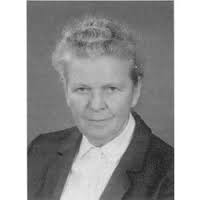Alla Selawry
Alla Selawry (Russian: Алла Сергеевна Селаври; 23 August 1913 – 27 July 1992), was a Russian scientist, Anthroposophist, doctor, homeopath, and theologian.

Biography
She was born in Moscow of Russian parents Sergei Ivanovich Selavri (Russian: Сергей Иванович Селаври) was a Sworn Attorney assistant and Antonina Georgievna Stasenkova (Russian: Антонина Георгиевна Стасенкова; March 10, 1886 in Stavropol - before 11 January 1965 in Stuttgart) (maiden name), and was the older sister of Dr. Oleg Selawry (Russian: Олег Сергеевич Селаври; February 21, 1924 – February 12, 1999).[1] Her family moved to Germany in 1922.
She graduated from the University of Tübingen in 1939 with a master's degree in medicine (MD). Shortly after graduating, she worked with Hans Krueger under the guidance of Ehrenfried Pfeiffer to develop Pfeiffer's medical diagnostic technique based on interpreting crystal formations of blood mixed in a copper chloride solution — also known as biocrystallization. She was so successful in this field that she set up a private practice which thrived until her death in 1992. She maintained that blood crystallisation belonged to the "science of the future" based more on intuition than on strictly repeatable, clinical trial studies.
She also developed homeopathic treatment regimens based on certain metals, many of which had properties described in mythological stereotypes (for example, gold, the metal of Apollo, the sun god, was used to treat the heart, the "sun" of the body).
In addition to her contributions to medical science, Selawry wrote a number a theological books, including: Perpetual Prayer of the Heart, a biography of John of Kronstadt, and an unfinished book on virtues and vices.
Selawry died on 27 July 1992 in Stuttgart, Germany, and was survived by her brother Oleg Selawry, and his children Mark and Lubov.
Publications
- Alla Selawry, and Oleg Selawry: "Die Kupferchlorid-Kristallisation in Naturwissenschaft und Medizin" (English: Copper Chloride Crystallization in Natural Science and Medicine.). Gustav Fischer Verlag, Stuttgart, 1957 (German)
- Alla Selawry, "Zinn und Zinn-Therapie" (English: Tin and Tin-therapy): Ulm / Donau: Haug, 1963 (German)
- Alla Selawry, "Herzensgebet : ein Weg geistiger Erfahrung ; nach Philokaleia (Berg Athos) und Was ist das Jesus-Gebet" (Walaam, Finnland) : Ulm/Donau : Arkana-Verl. Haug, 1964
- Alla Selawry, "Silber und Silber-Therapie : mit 15 Tabellen" '(English: 'Silver and Silver-therapy - with 15 tablets): Ulm: Haug, 1966 (German)
- Alla Selawry, "Samenkeimung und Metallpotenzen im Kristallisationstest" (English: Seed Germination and Metal Powers in Crystallization')': Darmstadt: Verl Research Foundation f. Biol-dynamic farming, 1975
- Alla Selawry, Das immerwährende Herzensgebet. Ein Weg geistiger Erfahrung (English: "Unceasing Prayer of the Heart.", Otto Wilhelm Barth Verlag, München 1970
- Alla Selawry, Ehrenfried Pfeiffer: Pioneer of spiritual research and practice: A contribution to his biography, Mercury Press, 1992.
- Alla Selawry, Ehrenfried Pfeiffer: Pionier spiritueller Forschung und Praxis: Begegnung und Briefwechsel: ein Beitrag zu seiner Biographie (Pioniere der Anthroposophie), Philosophisch-Anthroposophischer Verlag am Goetheanum, 1987. ISBN 3-7235-0449-3. (German)
- Alla Selawry: Johannes von Kronstadt: Starez Rußlands(English: "John of Kronstadt: Spiritual Elder of Russia"; Dornach: Pforte, 1989; ISBN 978-3-85636-064-1. (German)
- Alla Selawry, O Molitve Iisusovoj / ("On the Jesus Prayer"); Munchen : Bratstvo Prep. Iova Počaevskogo, 1990. ISBN 3-926165-20-0. (Russian)
References
- Oleg S. Selawry is the author of the books: Vincristine Treatment of Cancer in Children (1963); New Treatment Schedule with Improved Survival in Childhood Leukemia (1965); The Use of Liquid Cholesteric Crystals for Thermographic Measurement of Skin Temperature in Man (1966)
External links
- https://web.archive.org/web/20110223163123/http://www.anthromedia.net/fachdossiers/wissenschaften/naturwissenschaften/bildschaffende-methoden/die-methoden/information-fuer-aerzte-zur-blutkristallisation-e/
- http://biographien.kulturimpuls.org/detail.php?&id=601
- Москва - 1917, страница 439
- http://death-records.mooseroots.com/d/n/Oleg-Selawry%5B%5D
- Незабытые могилы, Российское зарубежье: т.1